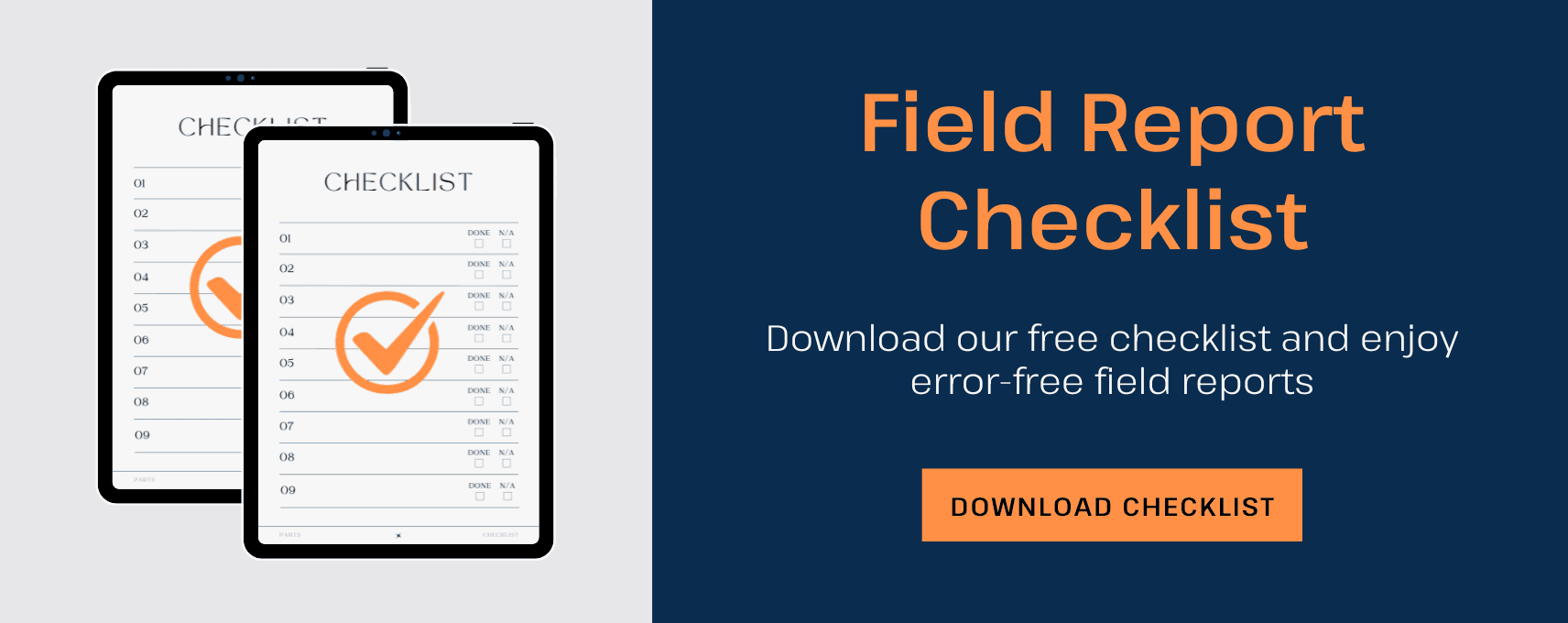BLOG
5 Tips for Better Field Reporting
Learn how to take your field reports up a notch, improve their usefulness, and make the process more efficient with these expert tips.
Jul 19, 2024
Field reporting is a nuanced thing, and there are two camps—one that despises it, and one that loves it. For those who despise it, it seems tedious and monotonous—even annoying as they walk around, catching glares of the crews whose progress they’re tracking. But for those who enjoy field reporting, it’s a change of pace and an enjoyable way to keep their finger on the pulse of the project.
But regardless of how you feel about it, there are ways to do it better. Whether it’s improving report clarity, better planning, or other methods, you can develop better, more useful field reports that help move the project forward rather than clogging up email inboxes.
This guide will cover five tips for better field reporting so these reports can become more than just mandatory paperwork.
5 Tips for Better Field Reporting
Field reporting might seem pretty cut and dry, but it doesn’t mean that you can’t improve upon the status quo. The following tips will help construction administrators deliver field reports worth reading.
1. Standardize Your Reports
Standardization may seem, well, pretty standard, but this is a potential area for improvement. Developing a field report template that you can use and adapt throughout the project ensures that you’re being thorough and covering all of the necessary aspects of the project.
Not only does this provide the architect or consultant creating the field report a baseline, but it also solidifies the way field reports are performed across the firm. This can improve efficiency across the entire company, allowing inspections to be performed faster without sacrificing thoroughness. Standardized reports also reduce the risks associated with missing an area of the project.
Try a few field report layouts before deciding on the best method. Try a layout that covers everything on a floor-by-floor basis and another that covers specialty contractor types. You might consider multiple text fields for writing, or simple progress percentage checkboxes with just a few areas for notes for each stage of the project.
2. Plan Your Path Ahead of Time, and Stick With It
Before starting your field report, plan your route ahead of time so you can move efficiently from area to area around the project site. This may require sitting with a set of plans and determining which paths to take so you’re not jumping around from area to area where you might potentially miss something.
There are a few reasons why path planning is so important. For one, it ensures you cover everything you intended to and nothing is left off the list. It also makes the field report easier to follow for anyone reading it, as the path should make sense to them and allow them to better visualize what the reporter is witnessing as they travel from area to area.
3. Write Clearly and Concisely
Think back to your school textbooks. Remember flipping to a page, praying for a picture or chart to take up most of the space? Only to see a block of text 30 lines long, followed by one break, and then another 30 lines? If you’re like most of us, you didn’t even bother reading all that.
There’s nothing more off-putting to a reader than long, exhausting, and confusing text. When creating your reports, use short sentences with as much simple, non-technical language as possible. Avoid stringing more than 3 or 4 sentences together to keep paragraphs or text blocks short and easy to digest.
Don’t make overuse of shorthand or abbreviations. Even though these writing styles or words are meant to save time, jamming too many instances into a sentence or paragraph will muddy the logical flow. Also, “homemade abbreviations” can be difficult to follow and might not make sense for everyone reading them.
With these points in mind, don’t unnecessarily break up blocks of cohesive text. If four sentences or phrases are relevant to each other and make sense in succession, keep them together. Sometimes breaking up cohesive thoughts into individual phrases will also break the flow and turn readers off because getting to the final point takes too much effort.

4. Know Your Audience
The trick to keeping anyone’s attention, whether you’re an architect, a stand-up comedian, or any other professional, is knowing your audience. This can be difficult to master but it’s an important point.
Architects, engineers, and designers know who is responsible for each aspect of the project. However, when you find deficiencies, your job is not to call them out based on whose responsibility they are. It’s simply to point these issues out and allow the general contractor to assign the item to the respective subcontractor.
As an example, let’s assume a field inspection resulted in finding five areas where drywall needs to be repaired due to damage from the construction process. Rather than documenting the issue and labeling it as “drywaller needs to repair,” simply write something along the lines of “GC to repair.”
Why? Well, for one, that’s your job. Your relationship is with the general contractor, not the subcontractors or other parties on the project. Also, as part of the design team, you don’t know who the general contractor assigned to that aspect of the project or the arrangement the GC has with the trade that damaged the wall. Documenting the issue and letting the general contractor handle it is the best policy.
5. A Picture is Worth a Thousand Words! (And It’s Never Been More True)
We’ve all heard the saying, but it’s rarely been more true. The more pictures that you have on hand to use in your field report, the better your field report will be.
It’s almost a given fact that you can never take too many pictures. At the end of the day, the picture you need is often blurry or underexposed, or the object you need a shot of is just out of sight. Take more pictures than you think you’ll need so you’re sure to have an excellent selection of available pictures.
For small deficiencies, be sure to take two pictures. Take one of the deficiencies in the room or space, and then a close-up of the actual issue. Small deficiencies, such as fire stop missing from around a pipe penetration, can be hard to find without a picture of the space, and understanding the deficiency can be difficult without a close-up. Take at least two pictures and leave notes in the report.
But remember, just because you have a thousand pictures doesn’t mean you need to include them all. Don’t just randomly select files and include them in the field report. Comb through them to find the best pictures that show exactly what you’re describing in the report. While it’s great to have a wide selection to choose from, including them all will turn people off from viewing them.
Bonus Tip: Use Field Reporting Software
While you can always draw up templates and create Microsoft Word documents, it’s not the most efficient method for creating field reports. The files grow too large with all of the images included, slowing the program to a snail’s pace. Luckily, there are better, faster, and more accurate methods for field reporting—using an app specifically designed for field reports.
Apps like Part3 make generating accurate, easily understandable field reports easier. Architects have the ability to develop and then follow templatized field reports. They’ll be able to create their own repeatable system for walking project sites and assembling reports, ensuring they don’t miss anything and their reports make sense and are easy to follow.
Field reporting apps also make distributing these important documents simple. The entire report can be converted to a PDF to prevent unauthorized editing. Then, rather than taking the file to your email, you can stay in the app and send the file to all of the folks who need to see it, saving time and improving communication.
👀 Get a sneak peek into Part3's platform to see how we streamline field reports:
Better Field Reporting with Part3
If you want more team members to read and understand your report, then you’re ready to take your field reporting to the next level. Part3 can help. Our solution can help you develop a plan, stick to it, and deliver clear, concise reports that make team members eager to read.
👉Book your demo with Part3 today!



